Geometrical order of colors
One-dimensional Order Systems
Straight line of different the Achromaticity Types
The logical and systematic order of all Achromaticity Types can be found on the Straight Line of Different Achromaticity Types, in a word the Achromaticity Types Line, see graphic below. The two achromatic Basic Colors W and K are at the ends of the line. Between the two extremes all possible gray shades are arranged in logical order. From a geometrical point of view it is a straight line.

Achromaticity Types Line (straight line of different Types of Achromaticity ) with the two achromatic Basic Colors W and K at the ends.
Hexagon of different Chromaticity Types
The logical and systematic order of all Chromaticity Types is the Hexagon of Different Chromaticity Types, in a word the Chromaticity Types Hexagon (see graphic below). The six chromatic Basic Colors are placed in the angles. On the straight line between two vicinal chromatic Basic Colors are all possible mixtures of the two in their logical order. From a geometrical point of view a hexagon consists of six straight lines. This represents the order of all pure chromatic colors.
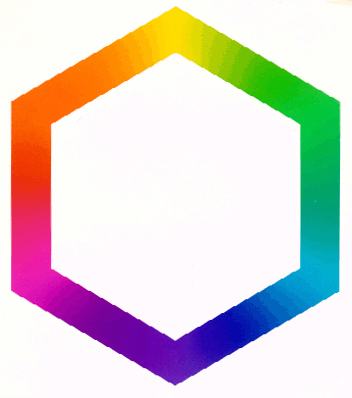
Chromaticity Types Hexagon (hexagon of different Types of Chromaticity) presenting the 6 chromatic Basic Colors in the angles
Two-dimensional Order Systems
Triangle of Identical Chromaticity Type
We find for all color shades of identical Chromaticity Type the logical and systematic order when mixing a single Chromaticity Type with all possible Achromaticity Types. The result is a triangular plane with the selected Chromaticity Type plus White and Black in the corners. We call it the Triangle of Identical Chromaticity Type, or Chromaticity Type Triangle (formerly called triangle of identical hue). The graphic shows the Chromaticity Type Triangle where the chromatic portion is filled in all the shades only by the Basic Color Green. This Chromaticity Type has been mixed with selected achromaticity grades.
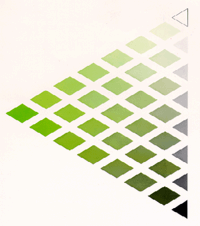
Chromaticity Type Triangle with the chromatic Basic Color Green
Hexagon of Identical Achromaticity Type
We find the logical and systematic order of all color shades of identical Achromaticity Type when we mix a single Achromaticity Type with all possible Types of Chromaticity. For that purpose we place the selected Achromaticity Type in the center of the Chromaticity Type Hexagon and mix in continuously all Chromaticity Types. By doing this we get a Hexagon of Identical Achromaticity Type or Achromaticity Type Hexagon. The graphic to the right shows the aspect of an Achromaticity Type Hexagon based on the achromatic Color W. The achromatic portion of all shades has been filled by the Achromaticity Type White. This new two-dimensional order system has been introduced by Harald Kueppers into the Theory of Color.
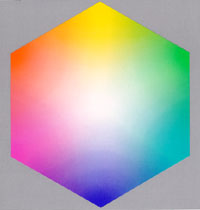
Achromaticity Type Hexagon with achromatic Basic Color White
Three-dimensional Order Systems
The logical and systematic result of mixing all Chromaticity and Achromaticity Types cannot be presented on a two-dimensional plane. A third dimension is necessary, in other words a color space, also called a color solid.
Rhombohedral Color Space
Kueppers considers his rhombohedral system the perfect color space model. It is a logically consistent vector model. The three sensory forces of the visual organ – the 3 Fundamental Colors – are the three vectors which are positioned in solid angles of 60 degrees with the achromatic Basic Color Black positioned in the lower edge of the rhombohedron. Strictly according to the rules of the parallelogram of forces each possible color sensation has its assigned geometrical spot within that color space. Every single spot is precisely defined by the potentials of the 3 Fundamental Colors. The LH picture shows the rhombohedron from the front (A) and in a 180° turn position (B). The RH picture is a diagrammatic view of the 8 Basic Colors located in the edges of the rhombohedron.
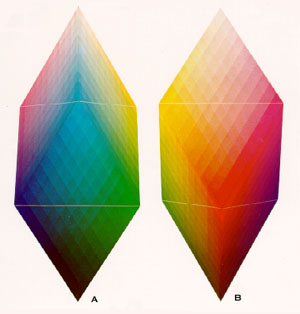
Rhombohedral color space B in a 180° turn compared with A
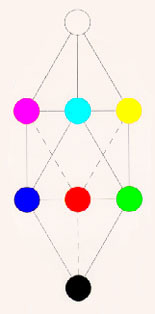
Arrangement of the 8 Basic Colors in the edges of the rhombohedral color space
Hexahedral Color Space (cube)
The cube is another interesting color space. It results when the vectors are positioned in 90° angles to point K . The cube is of great didactical value as its order in a right-angled geometric space is easy to understand. All planes of section which are running parallel to the exterior surface are squares. The advantage is that the order of the colors in a cube can be perfectly shown on quadratic color tables to be published in color atlases.
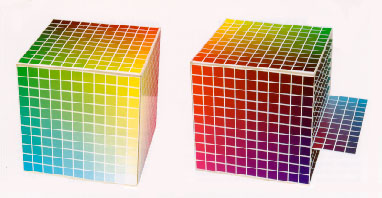
Hexahedral Color Space The right cube is 180° turned in comparison with the left one.

 Functioning Principle of Vision
Functioning Principle of Vision Color Mixing Laws
Color Mixing Laws Color and Printing Process
Color and Printing Process Theory of Color
Theory of Color Teaching Material and Literature
Teaching Material and Literature